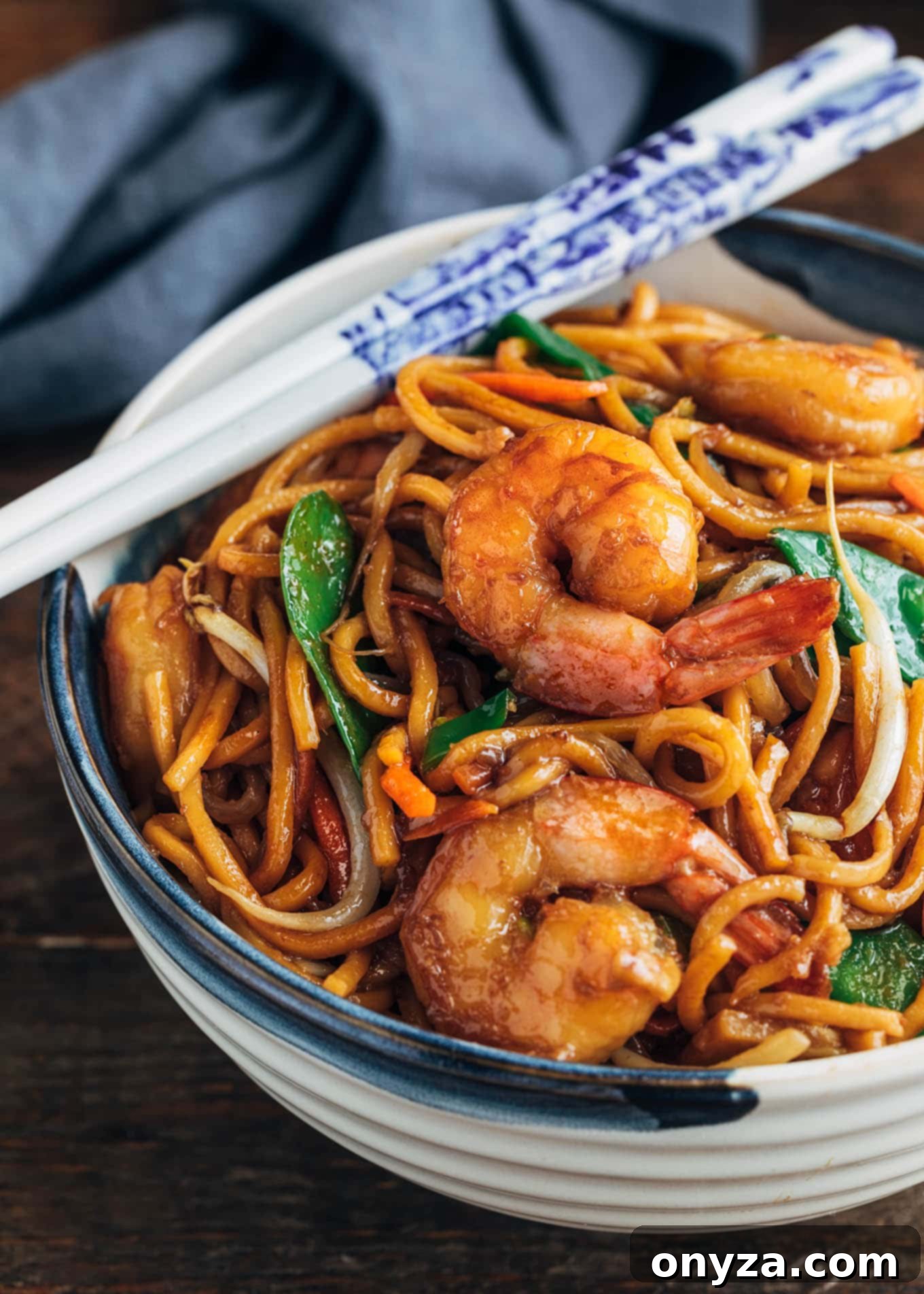Transform a beloved takeout classic into a homemade culinary masterpiece in just 30 minutes, with a mere 15 minutes of active cooking. This Shrimp Lo Mein recipe delivers tender egg noodles, vibrant crisp-tender vegetables, and succulent juicy shrimp, all bathed in a savory, aromatic sauce. It’s not only incredibly easy to prepare but also highly customizable, allowing you to tailor it to your personal taste with your favorite ingredients. Forget waiting for delivery – unlock the secrets to authentic, flavorful lo mein in your own kitchen tonight!

What is Lo Mein and How Does it Differ from Chow Mein? The Noodle Distinction
Understanding the difference between Lo Mein and Chow Mein is key to appreciating this classic dish. The name “Lo Mein” directly translates from Cantonese to “tossed noodles,” with “mein” (or “mian” in Mandarin) being the universal Chinese term for noodles. This translation provides a fundamental clue to the dish’s preparation: the noodles are boiled separately until perfectly al dente, then added at the very end to the stir-fried vegetables and protein, where they are gently “tossed” with the rich sauce. This method results in soft, springy noodles that are thoroughly coated in flavor.
In contrast, “Chow Mein” translates to “fried noodles,” signifying a distinct cooking approach and texture. For Chow Mein, noodles are typically par-cooked before being introduced to the wok or skillet, where they are stir-fried until they develop a crispier, chewier texture. Often, Chow Mein features noodles that are lightly pan-fried to achieve a desired crispiness on the exterior, while remaining tender on the inside. The sauce for Chow Mein is generally lighter and less abundant than that of Lo Mein, allowing the fried noodle texture to take center stage, often resulting in fewer vegetable and protein additions compared to its “tossed” counterpart. The contrasting cooking styles lead to a fundamental difference in mouthfeel: Lo Mein offers a softer, saucier noodle experience, while Chow Mein presents a firmer, often crispier, bite.
It’s worth noting that the culinary landscape of Chinese-American cuisine can introduce regional variations in how these terms are applied. In certain parts of the United States, particularly on the West Coast, what is commonly referred to as “Chow Mein” might closely resemble the soft, tossed noodles that East Coasters know as “Lo Mein.” For those seeking truly crispy noodles, terms like “Hong Kong Style Chow Mein” are often used to specify the desired crunchy texture. These regional nuances highlight the rich diversity within Chinese-American culinary traditions, underscoring the importance of knowing what to expect or simply asking when ordering.
Want to delve deeper? Explore the intricate differences between these two beloved noodle dishes with this in-depth comparison: Chow Mein vs Lo Mein from the San-J blog.
Choosing the Perfect Lo Mein Noodles for Your Dish
The foundation of any great Lo Mein recipe lies in the quality and preparation of its noodles. Traditional Chinese lo mein noodles are characteristically long, round, and made from wheat flour and egg, giving them their signature pale yellow hue and springy texture. They typically range in thickness from about 1/8-inch to 1/4-inch. You can find these versatile noodles in various forms: fresh, frozen, or dried.
For an unparalleled Lo Mein experience, I highly recommend opting for fresh lo mein noodles whenever possible. Their superior texture and quicker cooking time truly elevate the dish. Much like fresh Italian pasta, these noodles cook to a perfect al dente in just a few minutes, depending on their thickness, offering a delightful chewiness that dried noodles can sometimes lack.
Fresh lo mein noodles are typically stocked in the refrigerated section of most well-assorted Asian markets. They have a distinct light yellow color and should ideally be used within a couple of days of purchase or frozen for longer storage, as they are prone to molding if left too long in the refrigerator. If your local Asian market is out of reach, don’t despair! Many conventional grocery stores now carry these “fresh” noodles in their freezer section. Once defrosted overnight in the refrigerator, these frozen noodles perform just as beautifully as their fresh counterparts.
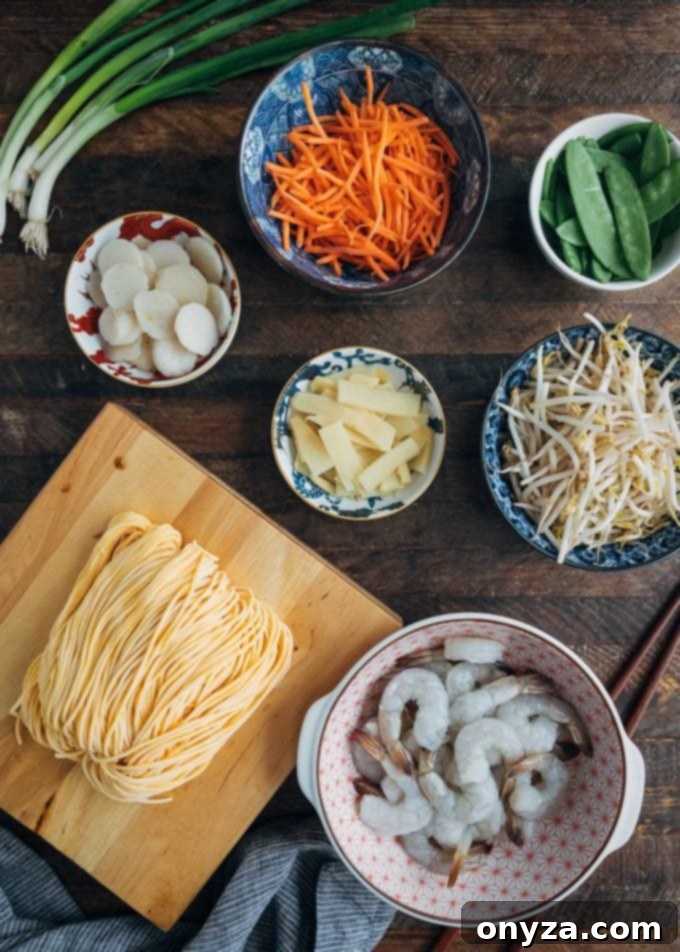
Should fresh or frozen options be unavailable, dried lo mein noodles are a perfectly acceptable substitute. These will require a slightly longer boiling time, typically around 5-6 minutes, to reach the desired al dente tenderness. You can often find them in the international aisle of larger grocery stores. In a pinch, for those truly unable to source authentic lo mein noodles, thicker varieties of Italian pasta such as spaghetti, bucatini, or linguine can serve as a decent stand-in. While this substitution won’t replicate the authentic takeout flavor profile precisely, it provides a viable option for a delicious homemade noodle dish.
Regardless of the type of noodle you choose, the most crucial step is to avoid overcooking them during the boiling process. You want them to be tender yet firm enough to hold their shape and not become mushy when tossed vigorously with the other ingredients and sauce. A perfectly cooked noodle forms the backbone of a successful Lo Mein.
Curious about Chinese egg noodles? Expand your noodle knowledge with this fascinating guide: Chinese Noodles 101 from Serious Eats.

Crafting the Perfect Homemade Shrimp Lo Mein
Shrimp Lo Mein is a fantastic recipe for busy weeknights, offering a burst of flavor and a satisfying meal without a lengthy cooking commitment. Its simplicity belies its deliciousness, making it a staple for anyone craving a taste of their favorite Chinese-American restaurant at home. One of the best ways to streamline the cooking process is to prepare your sauce and chop all your vegetables ahead of time. This “mise en place” approach ensures that once you start stir-frying, everything comes together swiftly, making dinner just as quick, if not quicker, than ordering takeout.
Choosing your shrimp: For this recipe, I typically use 26/30 count shrimp, which are medium-large in size and cook beautifully. If you need assistance navigating shrimp count labeling at the market, consult my Shrimp Sizes guide for more helpful information.
Do You Really Need a Wok for Lo Mein?
A common misconception is that a wok is essential for authentic stir-frying. While a wok’s unique shape and material are ideal for distributing heat evenly and allowing ingredients to be tossed effectively, it is absolutely possible to achieve excellent Lo Mein results using a large non-stick skillet (preferably 12-inches or larger) on your home stove. The key factor is not necessarily the specific type of pan, but rather ensuring your cooking vessel is sufficiently hot. Achieving a very high temperature in your pan is crucial for successful stir-frying, as it allows ingredients to sear quickly, developing rich flavors and desirable textures without steaming them. This rapid cooking process ensures vegetables remain crisp-tender and shrimp turns opaque and juicy in just a couple of minutes per element, preventing them from becoming rubbery or watery.
Elevate Your Lo Mein with Customizable Vegetables
One of the joys of making Lo Mein at home is the freedom to incorporate almost any vegetables you desire. The beauty of stir-frying lies in its adaptability. My personal favorites for Shrimp Lo Mein include crisp snow peas, vibrant shredded carrots, thinly sliced scallions, crunchy water chestnuts, tender bamboo shoots, and refreshing mung bean sprouts. These ingredients contribute a delightful mix of textures and fresh flavors.
However, the possibilities are virtually endless! Other popular and delicious additions include thinly sliced yellow onions, colorful bell pepper strips, finely shredded Napa cabbage, various types of mushrooms (shiitake, button, cremini), and florets of broccoli. As a general rule, if it can be stir-fried to a crisp-tender consistency, it can find a happy home in your Lo Mein. Consider adding your favorite seasonal vegetables to create a dynamic and ever-changing dish that perfectly suits your palate. The key is to cut your vegetables into uniform sizes to ensure even cooking and to add harder vegetables (like carrots or broccoli) earlier than softer ones (like sprouts or cabbage) to achieve the perfect texture throughout the dish.
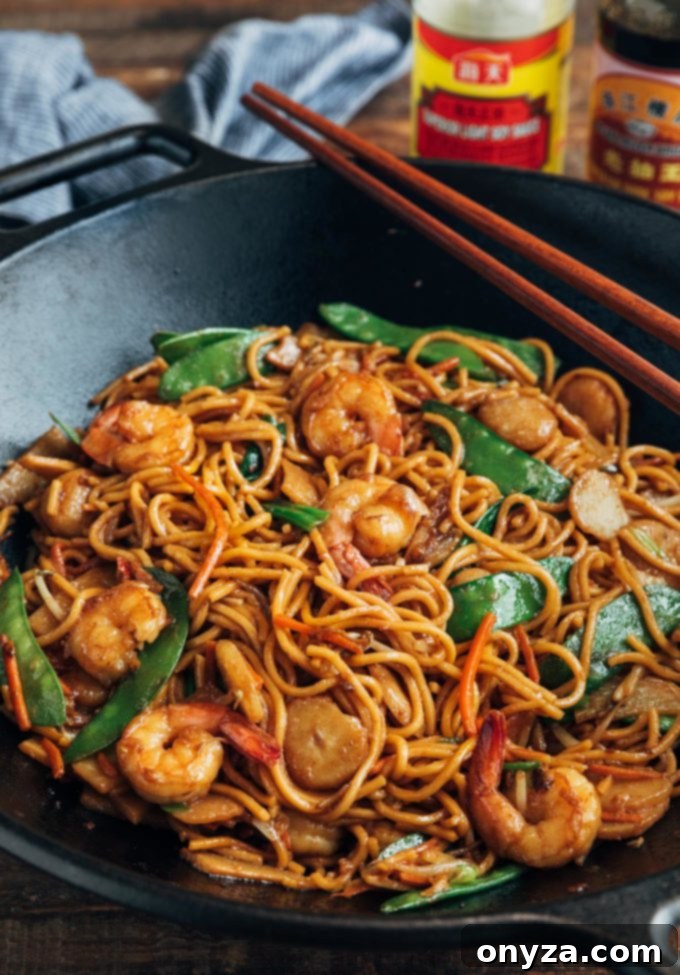
Mastering the Lo Mein Sauce: A Blend of Umami and Balance
The sauce is the soul of any Lo Mein dish, providing that irresistible savory depth and glistening coating that defines the experience. For our Shrimp Lo Mein, the sauce is a harmoniously simple yet profoundly flavorful combination of essential Chinese pantry staples. It features both dark and light soy sauces, Shaoxing wine, oyster sauce, a touch of granulated sugar to balance the savory notes, and a fragrant whisper of toasted sesame oil, finished with a pinch of ground white pepper for a subtle aromatic kick. This blend creates a sauce with incredible depth and complexity, perfectly seasoned to complement the noodles, shrimp, and vegetables.
A true anecdote from my own kitchen underscores a common concern: the first time I prepared this Lo Mein recipe, I tasted the sauce on its own before combining it with the rest of the ingredients. It struck me as intensely salty! I hesitated, wondering if I had mismeasured. However, I pressed on, trusting the recipe, and the result was perfectly seasoned. The critical point to remember is that the noodles themselves are quite bland, and the sauce is designed to generously coat and flavor a substantial volume of noodles, vegetables, and shrimp. When all components are combined, the sauce’s initial perceived saltiness balances out beautifully, transforming into a rich, umami-laden coating.
Dark soy sauce plays a unique role, not just in flavor, but in giving Lo Mein its characteristic deep, caramelized brown color and a subtle sweetness. If dark soy sauce is difficult to find, you can certainly use all light or all-purpose soy sauce. While the flavor of the finished dish will remain delicious and largely similar, the color of your noodles will be noticeably lighter, missing that signature dark hue.
For those mindful of sodium intake, substituting low-sodium soy sauce for the light soy sauce is an easy way to reduce the salt content without sacrificing flavor. Additionally, for vegetarian or vegan versions, there are excellent mushroom-based “oyster sauce” alternatives available that provide a similar savory depth.
Unlock your Chinese cooking pantry: To confidently navigate the aisles of your Asian market and understand these key ingredients better, explore my comprehensive guide: Chinese-Inspired Cooking: Pantry Essentials.
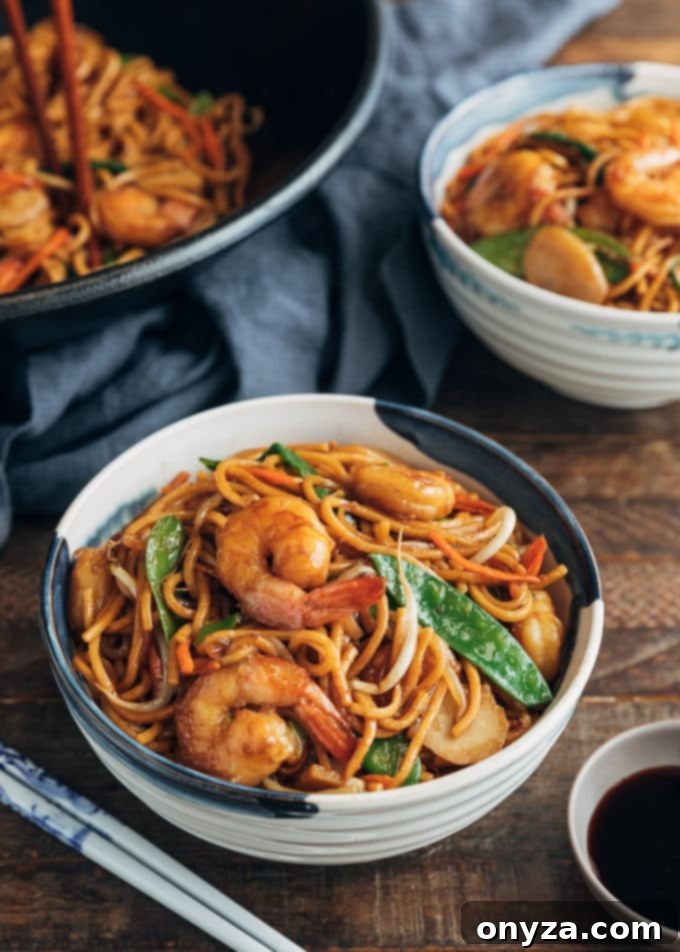
Serving and Enjoying Your Homemade Shrimp Lo Mein
The beauty of homemade Shrimp Lo Mein lies not only in its delightful flavors but also in its versatility at the table. I always recommend serving Lo Mein promptly after stir-frying. This ensures that the vegetables retain their optimal crisp-tender texture and vibrant color, and the noodles are perfectly coated and warm. For guests, or for your own enjoyment, offering a few optional condiments can truly enhance the dining experience. A small dish of extra soy sauce allows for a fresh pop of umami and customizable saltiness. For those who appreciate a fiery kick, a drizzle of high-quality chili oil adds an exciting layer of heat and depth. And for a bright, tangy counterpoint that can cut through the richness of the dish, a few drops of rice vinegar can be a delightful addition.
Just like your favorite takeout, homemade Lo Mein makes for fantastic leftovers. It reheats remarkably well the next day, transforming into a quick and satisfying lunch or an easy second-night dinner. A useful tip for reheating, especially if using a microwave, is to remove the shrimp before the final stage of warming. Shrimp can quickly become tough and rubbery when overcooked, so adding them back in during the last minute or two of reheating helps preserve their tender, juicy texture. This simple step ensures that your reheated Lo Mein tastes almost as good as it did fresh from the wok.
Pair your Shrimp Lo Mein with other Chinese-inspired dishes for a full feast. Simple steamed dumplings, savory egg rolls, or a comforting bowl of wonton soup can beautifully complement the noodle dish. For a lighter accompaniment, a fresh cucumber salad dressed with sesame oil and rice vinegar works wonderfully to balance the rich flavors.
More Chinese Takeout Inspired Recipes to Explore
- Crispy Fried Wonton Strips
- Comforting Wonton Soup
- Classic Beef and Broccoli
- Zesty General Tso’s Chicken
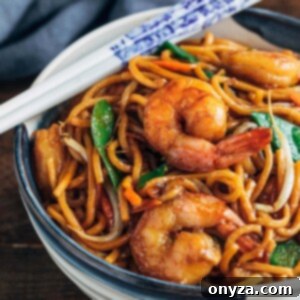
Print Recipe
★
★
★
★
Shrimp Lo Mein
Amanda Biddle
15
minutes
15
minutes
30
minutes
4
to 6 people
Ingredients
- 1 pound lo mein noodles (fresh, if possible)
Sauce
- 2 tablespoons light soy sauce
- 1 tablespoon dark soy sauce
- 2 tablespoons Shaoxing wine
- 2 tablespoons oyster sauce
- 1 teaspoon granulated sugar
- 1 teaspoon toasted sesame oil
- pinch ground white pepper
Stir-Fry
- 6 scallions
- 3 tablespoons vegetable oil , divided
- 1 cup shredded carrots
- 1 cup snow peas , trimmed
- 8 ounce can water chestnuts , drained
- 8 ounce can bamboo shoots , rinsed and drained
- 1 pound raw shrimp (26/30) peeled, deveined, tail on or off
- 1 tablespoon minced garlic cloves
- 2 teaspoons grated fresh ginger (I use a microplane)
- 2 cups mung bean sprouts
- extra soy sauce, chili oil, and/or rice vinegar , for serving (optional)
Instructions
Make the Noodles
- Boil lo mein noodles in a pot of lightly-salted water for 3-5 minutes, until al dente. Drain and rinse under cool water. Set aside.
Make the Sauce
- While the noodles are boiling, whisk together light and dark soy sauces, Shaoxing wine, oyster sauce, sugar, sesame oil, and white pepper in a bowl. Set aside.
Make the Stir-Fry
- Cut the scallions in half to divide them into the dark green and white/light green parts. Thinly-slice the white/light green parts. Cut the dark green parts into 1 or 2 segments of about 2 inches. Set aside.
- Heat a wok or large (12-inch) skillet over high heat until very hot. Add 1 tablespoon vegetable oil and sauté carrots, snow peas, water chestnuts, and bamboo shoots for about 2 minutes, until crisp-tender. Remove from the pan and set aside.
- Heat another tablespoon of oil in the wok or pan and sauté shrimp until pink, translucent, and lightly brown on the edges, about 2-3 minutes. Remove from the pan and set aside.
- Heat the remaining 1 tablespoon of oil in the wok or pan and add garlic, ginger, and the sliced white and light green scallions. Sauté for 1 minute. Add sautéed vegetables, shrimp, noodles, and bean sprouts to the pan, tossing to combine.
- Pour the sauce mixture around the sides of the pan and add the dark green scallion parts. Cook, tossing, for 1-2 minutes.
- Taste the lo mein. Season to taste with additional soy sauce and ground white pepper, if desired. Serve hot or warm, with soy sauce to pass at the table, a drizzle of chili oil if you like the dish spicy, or a few drops of rice vinegar for a tangy finish (all optional).
Nutrition Estimate
Calories: 711kcal |
Carbohydrates: 103g |
Protein: 39g |
Fat: 15g |
Saturated Fat: 9g |
Cholesterol: 285mg |
Sodium: 2263mg |
Potassium: 510mg |
Fiber: 7g |
Sugar: 8g |
Vitamin A: 5790IU |
Vitamin C: 33.5mg |
Calcium: 216mg |
Iron: 4.8mg
Nutrition information is automatically calculated, so should only be used as an approximation.
Please note that our recipes have been developed using the US Customary measurement system and have not been tested for high altitude/elevation cooking and baking.
Like this? Rate and comment below!
